OBS
Oxygen Atom Beam Source
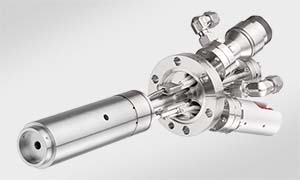
OBS 40 Oxygen Atom Beam Source on DN40CF (O.D. 2.75") flange with aperture plate
-
O2 dissociation up to more than 80%, depending on operation conditions
-
Atomic oxygen flux density up to 1x1015/cm2 s
-
No high-energy particles and ions
-
Low power consumption
-
Integrated water cooling, low thermal load on other experimental equipment
-
Optional customized aperture
The Oxygen Atom Beam Source OBS is a thermal gas cracker that produces an ion-free oxygen gas beam, thus avoiding ion induced damage to the substrate. It features a very compact design and is easy to install and to operate.
In contrast to oxygen plasma sources based on HF or HV ionization of gas molecules, or gas sources heated by HV electron bombardment, the OBS is heated by a DC operated filament, which surrounds a long cracking tube.
Developed in collaboration with Dr. Karl Georg Tschersich of the Institute of Bio- and Nanosystems (formerly Institute of Thin Films and Interfaces) at Juelich Research, the OBS is an extensively tested and well characterized oxygen source.
|
The intensity of the source can be controlled by the flow rate of oxygen and the heating power. The heating power determines the temperature of the cracking tube. Operation temperatures up to 1700°C provide an efficient thermal cracking of O2 molecules within the tube. |
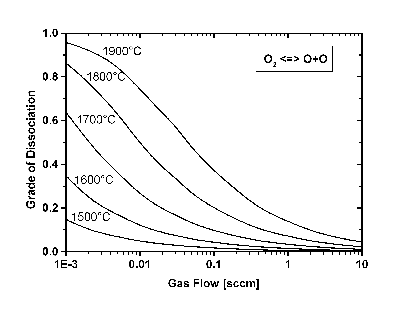 Grade of dissociation as a function of the gas flow for typical cracking tube temperatures of the OBS (values are calculated for thermodynamical equilibrium conditions) |
|
|
Despite the high temperatures needed for thermal gas cracking, the thermal load on the chamber is negligible, due to the integrated water cooling and use of a small diameter aperture (optional). |
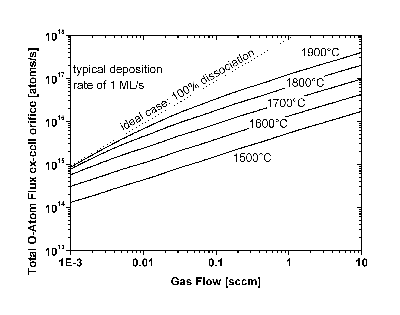 Total flux of O-atoms leaving the cell orifice for different cell operation parameters (gas flow and tube temperature). A flux of about 1*1017 atoms/s corresponds to a typical deposition rate of 1 monolayer/s at a substrate distance of about 200mm |
Application
The use of a long, slender cracking tube results in a narrow angle distribution of the atomic oxygen beam (typical FWHM: 10-30°) which makes the OBS ideally suited for medium and low gas flux applications (up to 0.1 sccm) on smaller sample sizes or long substrate distances.
Due to its highly efficient oxygen cracking mechanism and the resulting low gas load on the vacuum system, the OBS can likewise be applied in standard UHV, MBE, and ALD systems as a reliable, highly efficient and low cost source for atomic oxygen.
Typical applications for the OBS are:
Oxide layer deposition
The OBS allows precise layer deposition of oxide layers, due to the fast and easy control of the gas flow by shutter or UHV leak-valve.
Surface cleaning procedures
Atomic oxygen is used for removal of surface carbon contaminations.
Surface oxidation
In surface analysis applications as well as in ALD technology atomic oxygen is used for the preparation of well defined oxide surface layers.
Atomic spectroscopy of single atoms
The particle density of about 1011 low energy O-atoms per cm3 near the cell exit allows a wide range of fundamental spectroscopic experiments on single O-atoms.
Several publications to OBS are listed in section References / List of Publications.
Gas Injection System |
|
| For optimized performance, we offer a complete gas injection system for atomic oxygen. The gas injection system is completely assembled and only an O2 gas cylinder is required to start operation. A simple turbo molecular pump can be used to evacuate the O2 gas line. The O2 gas line and all-metal leak valve can be baked to 180°C. Alternatively, the gas injection system can be equipped with a mass flow controller (MFC) plus an all-metal valve instead of an all-metal UHV leak valve. A mass flow controller in the gas line is preferred when the OBS is used primarily for high intensity, long term runs, where mass flow controllers require less attention due to their automated operation compared to the gas feed setup above. There are many different mass flow controllers on the market. It is recommended that the customer provide the MFC. The maximum system bake-out temperature depends on the specification of the MFC used. |
|
|
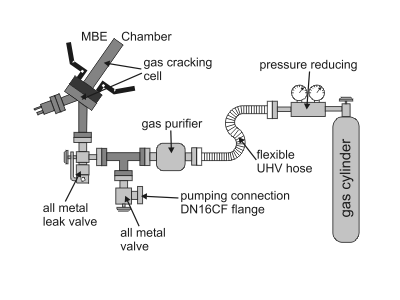 Gas injection system with all-metal leak valve. In the alternative design with mass flow controller (MFC), the all-metal leak valve is replaced by an MFC and an all-metal valve. Gas injection system with all-metal leak valve. In the alternative design with mass flow controller (MFC), the all-metal leak valve is replaced by an MFC and an all-metal valve. |
Technical data |
|
| Filament type | DC heated low voltage filament |
| Gas line | filament heated cracking tube |
| Thermocouple | W5%Re/W26%Re (type C) |
| Bakeout temperature | 250°C |
| Operating temperature | up to 1700ºC |
| Cooling | integrated water cooling |
| Accessories | aperture plate |
| leak valve | |
Dimensions
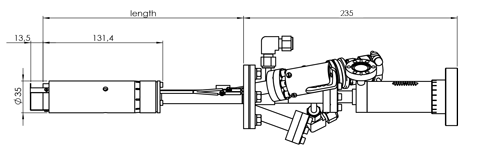 |
Schematic drawing of the Oxygen Atom Beam Source OBS (drawing shows OBS 40 with optional aperture and leak valve) |
Specific data
For general information on CF mounting flanges see Flange and Gasket dimensions.
 |
 |
 |
 |
||
|---|---|---|---|---|---|
| [mm] | [mm] / [mm] | [W] | [A] | [V] | |
| OBS | 40- | L190-400 / D36 | <200 | < 15 | < 15 |
| *** | specify UHV length L with order | |||
Product code:
e.g. OBS 40-L220D36
is an oxygen atom beam source on DN40CF flange with UHV-length 220 mm and in-vacuum diameter 36 mm.
Related products
The following list provides suggestions for related products. For additional product suggestions or more detailed information, please contact us.
Components
 |
 |
|
| Hydrogen Atom Beam Source HABS |
Free Microplasma Source FMP |
Accessories
 |
||
| Cooling Shrouds CS |
Systems
 |
 |
 |
| OCTOPLUS 300 | OCTOPLUS-O 400 | OCTOPLUS 600 |
